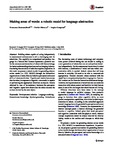Making sense of words: a robotic model for language abstraction
| dc.contributor.author | Stramandinoli, F | |
| dc.contributor.author | Marocco, D | |
| dc.contributor.author | Cangelosi, Angelo | |
| dc.date.accessioned | 2017-02-19T14:50:51Z | |
| dc.date.accessioned | 2017-08-10T12:06:59Z | |
| dc.date.available | 2017-02-19T14:50:51Z | |
| dc.date.available | 2017-08-10T12:06:59Z | |
| dc.date.issued | 2017-02 | |
| dc.identifier.issn | 0929-5593 | |
| dc.identifier.issn | 1573-7527 | |
| dc.identifier.uri | http://hdl.handle.net/10026.1/9727 | |
| dc.description.abstract |
Building robots capable of acting independently in unstructured environments is still a challenging task for roboticists. The capability to comprehend and produce language in a ‘human-like’ manner represents a powerful tool for the autonomous interaction of robots with human beings, for better understanding situations and exchanging information during the execution of tasks that require cooperation. In this work, we present a robotic model for grounding abstract action words (i.e. USE, MAKE) through the hierarchical organization of terms directly linked to perceptual and motor skills of a humanoid robot. Experimental results have shown that the robot, in response to linguistic commands, is capable of performing the appropriate behaviors on objects. Results obtained in case of inconsistency between the perceptual and linguistic inputs have shown that the robot executes the actions elicited by the seen object. | |
| dc.format.extent | 367-383 | |
| dc.language | en | |
| dc.language.iso | en | |
| dc.publisher | Springer Science and Business Media LLC | |
| dc.relation.replaces | http://hdl.handle.net/10026.1/8537 | |
| dc.relation.replaces | 10026.1/8537 | |
| dc.subject | Developmental robotics | |
| dc.subject | Language modeling | |
| dc.subject | Sensorimotor knowledge | |
| dc.subject | Symbol grounding | |
| dc.subject | Embodiment | |
| dc.title | Making sense of words: a robotic model for language abstraction | |
| dc.type | journal-article | |
| dc.type | Journal Article | |
| plymouth.author-url | https://www.webofscience.com/api/gateway?GWVersion=2&SrcApp=PARTNER_APP&SrcAuth=LinksAMR&KeyUT=WOS:000393817500006&DestLinkType=FullRecord&DestApp=ALL_WOS&UsrCustomerID=11bb513d99f797142bcfeffcc58ea008 | |
| plymouth.issue | 2 | |
| plymouth.volume | 41 | |
| plymouth.publication-status | Published | |
| plymouth.journal | Autonomous Robots | |
| dc.identifier.doi | 10.1007/s10514-016-9587-8 | |
| plymouth.organisational-group | /Plymouth | |
| plymouth.organisational-group | /Plymouth/Faculty of Science and Engineering | |
| plymouth.organisational-group | /Plymouth/PS - Academic Partnerships | |
| plymouth.organisational-group | /Plymouth/Research Groups | |
| plymouth.organisational-group | /Plymouth/Research Groups/Institute of Health and Community | |
| plymouth.organisational-group | /Plymouth/Research Groups/Marine Institute | |
| dcterms.dateAccepted | 2016-06-23 | |
| dc.identifier.eissn | 1573-7527 | |
| dc.rights.embargoperiod | Not known | |
| rioxxterms.funder | EPSRC | |
| rioxxterms.identifier.project | BABEL | |
| rioxxterms.versionofrecord | 10.1007/s10514-016-9587-8 | |
| rioxxterms.licenseref.uri | http://www.rioxx.net/licenses/all-rights-reserved | |
| rioxxterms.licenseref.startdate | 2017-02 | |
| rioxxterms.type | Journal Article/Review | |
| plymouth.funder | BABEL::EPSRC | |
| plymouth.oa-location | http://link.springer.com/article/10.1007/s10514-016-9587-8 |


